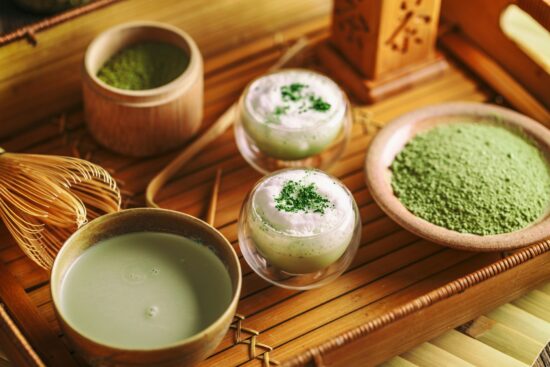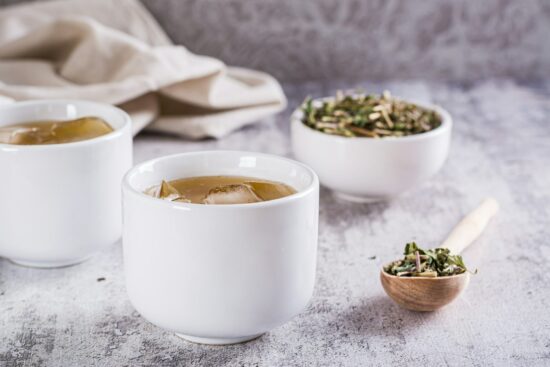
For health enthusiasts and casual tea drinkers alike, the choice between matcha and regular green tea often comes down to personal preference in flavor, preparation, and the health benefits each offers. Exploring the differences and similarities between matcha and regular green tea is about taste preferences and understanding their nutritional profiles and how they fit into a healthy lifestyle.
Whether you’re looking to boost your antioxidant intake, seek a calming ritual, or simply explore different teas’ tastes, understanding these two popular options can enhance your tea-drinking experience. So, let’s get into what sets matcha apart from regular green tea and why you might choose one over the other in your daily routine.
Quick answer: The main difference between matcha and regular green tea lies in their production process and how they are consumed. Matcha is made from whole tea leaves that are ground into a fine powder, consumed entirely, and renowned for its vibrant green color, rich texture, and higher concentration of antioxidants, caffeine, and L-theanine. In contrast, regular green tea involves steeping the leaves in hot water, resulting in a lighter beverage with a more delicate flavor and a lower concentration of nutrients due to the infusion process rather than consuming the whole leaf.
Nutritional Comparison Between Matcha And Green Tea
Regarding nutritional content, matcha and regular green tea offer a treasure trove of health benefits thanks to their rich antioxidants, caffeine, and L-theanine profiles. However, how these teas are processed and consumed impacts their nutritional value differently.

Antioxidants
Matcha is renowned for its high antioxidant content, particularly catechins, a type of phenolic compound. Since matcha is made from ground whole tea leaves, drinkers consume the entire leaf, not just an infusion. This means matcha provides a more concentrated source of antioxidants than regular green tea.
Antioxidants protect our cells from damage by free radicals and support overall health. Regular green tea, while also a good source of antioxidants, delivers them in lesser quantities than matcha. This is because only some of the nutrients are extracted into the water during brewing.
Caffeine Levels
There’s a significant difference in caffeine content between matcha and regular green tea. Matcha contains more caffeine since it is consumed entirely, providing a fuller release of this stimulating compound.
The caffeine content in matcha can vary but generally falls between 60 to 70 mg per serving, compared to regular green tea, which typically contains about 30 to 50 mg per serving. This makes matcha a stronger choice for those seeking a more robust energy boost.
L-Theanine
Both teas contain L-theanine, an amino acid known for its calming effects on the brain, promoting relaxation without drowsiness. Matcha, however, tends to have higher levels of L-theanine because of the shade-growing process, which increases the chlorophyll and L-theanine content in the leaves.
This process, unique to matcha production, also contributes to its distinctive umami flavor. L-theanine works synergistically with caffeine in matcha to provide a sustained release of energy without the jitteriness that can come from coffee.
Processing Effects
The differences in nutritional content can be largely attributed to the processing methods. For matcha, the tea leaves are shaded for about three weeks before harvest to boost chlorophyll and amino acid levels. After harvesting, the stems and veins are removed, and the leaves are ground into a fine powder. This method preserves the nutrients effectively.
Regular green tea is processed by either steaming (Japanese method) or pan-firing (Chinese method) the leaves, then rolling and drying them. This process does allow for some nutrient loss compared to the whole-leaf consumption method of matcha.
Understanding these nutritional nuances can help tea drinkers make informed decisions based on their health goals, energy needs, and flavor preferences. Whether you lean towards the potent, antioxidant-rich matcha or the subtler, soothing regular green tea, both offer valuable benefits to your health and well-being.
Health Benefits

Matcha and regular green tea are celebrated not just for their distinct flavors but also for their impressive array of health benefits. Both have been the subject of extensive research, with studies highlighting their potential to improve heart health, aid in weight management, and reduce the risk of chronic diseases.
Matcha Health Benefits
- Enhanced Heart Health: Matcha is rich in catechins, particularly epigallocatechin gallate (EGCG), which have been shown to have protective effects against heart diseases. A study published in the “Journal of the American Heart Association” suggests that catechins can help lower bad cholesterol levels and improve artery function, reducing the risk of heart disease.
- Weight Management: The combination of caffeine and catechins in matcha appears to have a synergistic effect that can enhance fat oxidation during exercise, as found in research from the “American Journal of Clinical Nutrition.” This suggests that matcha could be a beneficial addition to a weight loss or weight management regimen.
- Brain Health: Matcha’s high levels of L-theanine and caffeine not only improve focus and energy levels but may also protect the brain. Studies, including one in the “Journal of Medicinal Food,” have shown that these compounds can enhance cognitive function, potentially lowering the risk of cognitive diseases.
Regular Green Tea Health Benefits
- Antioxidant and Anti-inflammatory Effects: Regular green tea is a good source of antioxidants, which can reduce oxidative stress and inflammation in the body. This has implications for reducing the risk of chronic diseases such as cancer, with studies in the “International Journal of Molecular Sciences” highlighting green tea’s potential in cancer prevention.
- Cardiovascular Health: Similar to matcha, regular green tea consumption has been associated with a lower risk of cardiovascular diseases. Research in the “European Journal of Cardiovascular Prevention & Rehabilitation” has shown that green tea can improve blood lipid profiles and endothelial function, contributing to heart health.
- Diabetes Risk Reduction: Both matcha and regular green tea may help regulate blood sugar levels, reducing the risk of type 2 diabetes. A systematic review and meta-analysis published in the “Annals of Internal Medicine” found that higher consumption of green tea was associated with a lower risk of type 2 diabetes.
Shared Benefits
Both matcha and regular green tea share these health benefits due to their common plant origin, Camellia sinensis. The difference in the concentration of bioactive compounds arises from the distinct processing methods and consumption forms, with matcha providing a more concentrated form of nutrients and antioxidants due to its whole-leaf consumption.
Incorporating matcha or regular green tea into your daily routine can contribute to a healthier lifestyle, offering a range of benefits supported by scientific research. Whether you prefer the intense, rich flavor of matcha or the subtle, refreshing taste of green tea, both can play a part in a balanced, health-conscious diet.
Taste And Aroma

The taste and aroma profiles of matcha and regular green tea are distinct, shaped not only by their unique processing methods but also by how they are prepared. These differences are key to understanding the sensory experience each tea offers, appealing to various preferences and occasions.
Matcha Taste and Aroma
Matcha is characterized by a rich, full-bodied flavor that is both complex and nuanced. Its taste can be described as a harmonious blend of umami (savory) and slight bitterness, with underlying sweet notes that can vary depending on the quality of the matcha.
The high chlorophyll content in matcha, a result of the shade-growing process, contributes to its vibrant green color and a grassy, slightly sweet aroma. Premium grades of matcha tend to have a smoother flavor and less bitterness, with a creamy texture that is highly valued.
Preparation plays a crucial role in the flavor and aroma of matcha. Traditional whisking in a bowl with hot water (not boiling, to avoid bitterness) creates a frothy, smooth beverage that fully releases its rich, complex flavors and distinct grassy aroma. The temperature and quality of water, as well as the ratio of matcha powder to water, can significantly influence the final taste, making it adaptable to personal preference.
Regular Green Tea Taste and Aroma
Regular green tea offers a more varied taste profile, ranging from sweet and floral to vegetal and nutty, depending on the type (e.g., Sencha, Dragonwell) and its origin. Unlike matcha, which is made from ground tea leaves, regular green tea is typically steeped, allowing the hot water to extract flavors and aromas from the leaves. The infusion process results in a lighter body compared to matcha, with a delicate balance of sweetness and astringency, and a clean, refreshing aftertaste.
Preparation Methods

The aroma of regular green tea can be equally diverse, with some varieties exuding a strong floral scent, while others might have a more subdued, grassy, or seaweed-like aroma. The steeping time and water temperature greatly influence the flavor and aroma of green tea. Generally, brewing with water just below boiling temperature and for a shorter duration yields a smoother taste and reduces bitterness.
How to Prepare Matcha
Ingredients and Tools:
- High-quality matcha powder
- Hot water (just under boiling, around 175°F or 80°C)
- A matcha whisk (chasen)
- A matcha bowl (chawan)
Steps:
- Preheat the Bowl: Pour some hot water into the matcha bowl to warm it up, then discard the water and dry the bowl. This step ensures that the matcha tea does not cool down too quickly during preparation.
- Sift the Matcha: Using a fine sieve, sift 1-2 teaspoons of matcha powder into the bowl. Sifting prevents clumps and ensures a smooth tea.
- Add Water: Pour about 2 ounces (60 ml) of hot water into the bowl. The ideal water temperature is around 175°F (80°C) to prevent bitterness.
- Whisk Vigorously: Using the matcha whisk, whisk the matcha and water briskly in a W or M motion until a frothy foam with tiny bubbles forms on the surface. This usually takes about 15-30 seconds.
- Enjoy: Drink your matcha straight from the bowl, enjoying the creamy texture and vibrant flavor.
How to Prepare Regular Green Tea
Ingredients and Tools:
- Green tea leaves (or a tea bag)
- Hot water (ideally around 175°F or 80°C)
- A teapot or a cup
Steps:
- Heat Water: Bring your water to a simmer but not to a boil. If you don’t have a thermometer, let boiling water cool for about 5 minutes.
- Preheat the Teapot/Cup: Pour some hot water into the teapot or cup to warm it, then discard this water. This step helps maintain the temperature during steeping.
- Add Tea Leaves: Place about 1 teaspoon of green tea leaves per cup (8 oz) into the teapot or use one tea bag for a single cup.
- Steep: Pour the hot water over the tea leaves or tea bag. Let the tea steep for 1 to 3 minutes, depending on how strong you like your tea. Shorter steeping times result in a milder flavor.
- Serve: Strain the tea leaves from the water or remove the tea bag. Pour the brewed tea into cups and enjoy.
The temperature of the water is crucial for both matcha and green tea; too hot can release more bitterness and degrade some beneficial antioxidants.








Leave a Reply